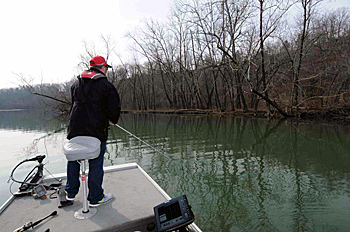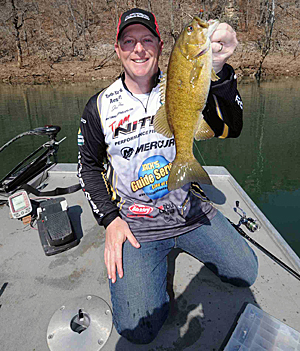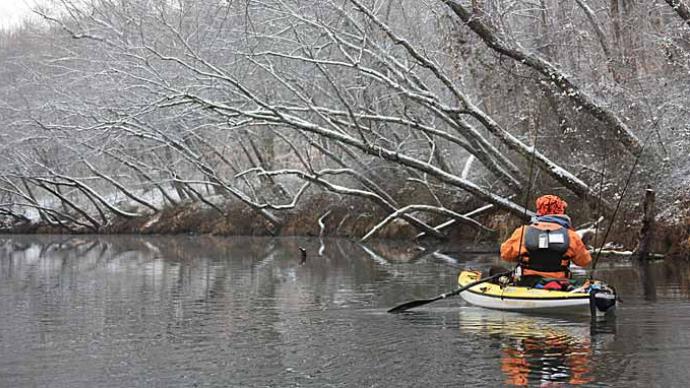
Fishing streams for smallmouth bass offers a small-water alternative for bass anglers on a strict budget.
“Anybody can afford an old pair of torn-up tennis shoes (for wading),” said Jack Uxa, a Missouri guide who has been fishing streams throughout his home state since he was about nine years old. Uxa waded streams for several years since he couldn’t afford a bass boat. Although Uxa owns a bass boat now and guides on Lake of the Ozarks, he still takes clients on smallmouth bass trips to the rivers near the lake. Uxa has also replaced his old wading tennis shoes with a jet-drive aluminum boat for running the rivers.
His extensive stream fishing experiences have taught Uxa how to read rivers and find smallmouth hideouts. He suggests finding the right areas in a stream is the key to getting bites. “Try to find a fast-moving stretch of water, and then all of a sudden there is a turn in the stream, then you have a little deep water,” Uxa says. He notices smallmouth usually holding at the deep pool's front end.
The Missouri angler also finds brown bass along laydown logs in the deep pools. “You won’t catch as many numbers of fish, but sometimes you will catch the biggest fish of the day if you target those isolated laydowns, especially with a buzz bait,” he says.
Depending on the season, water flow can factor in finding smallmouth in streams. “In the wintertime, I don’t want any current at all,” Uxa said. “I am looking for deep pools then. In the summertime, it is the opposite; I want to find a lot of current.”
During the winter, Uxa finds large schools of smallmouth holding in pools around 14 feet deep. Uxa has trouble finding smallmouth in the spring when the fish scatter to spawn and in the fall when smallies move around a lot. Smallmouth are easier to find in the summertime, but the fish gather in smaller groups of only two or three bass to a spot. “They get very predictable as it gets warmer because as soon as you get in the right situation, you are going to get a bite, but then you might have to go an eighth of a mile to get to the next pool and the next right situation,” Uxa said. “Then, you will get an immediate bite once you get there.”
Getting bites from stream smallmouth doesn’t require downsizing lures, even though the fish have smaller mouths than their largemouth cousins. “Smallmouths are aggressive,” Uxa said. “They have no qualms in taking down large topwaters or buzz baits.”

The guide suggests you will catch better numbers of fish on smaller baits but more quality bass with bigger baits. His favorite lure for catching quality smallmouth is a black or white-and-chartreuse 3/4-ounce Crock-O-Gator Head Knocker Buzzbait.
“A jig is probably my number one bait for smallmouth,” Uxa says. He favors a 1/2-ounce jig in brown/chartreuse, brown/orange, black/blue, or gourd green/green flash tipped with either a Bass Pro Shops Incredible Craw or Berkley PowerBait Chigger Chunk in the same colors as the jig. Uxa selects the Chigger Chunk to give his lure a larger profile with lots of tail action and opts for the Incredible Craw to make a more subtle-looking bait with a more natural action.
For most of his lure presentations, Uxa casts upstream and lets the lure flow back towards him. As the lure drifts with the current, Uxa reels in the slack line to stay in better contact with the bait. Uxa notes you can retrieve lures at a faster pace for smallmouth in streams, even during the dead of winter. “Smallmouth are okay with tracking down a bait,” says Uxa, who likes a high-speed retrieve for his buzz baits.
Since he wants his clients to catch several fish, Uxa usually sets them up with spinning tackle and 6- or 8-pound test line for throwing small finesse worms or soft plastics. He also takes along baitcast outfits with 12- to 17-pound fluorocarbon line for fishing larger jigs, buzz baits, and spinnerbaits. He never uses line heavier than 17-pound test on the river because the thicker line tends to catch the current more than lighter lines. “Then your bait is not getting down to the bottom, and with almost all fishing, bottom contact is one of those things that plays a big role,” Uxa says.
Late sleepers will enjoy stream fishing for smallmouth since the fish have no set timetable for eating. Uxa notices smallmouth bass in streams bite more consistently throughout the day, whereas largemouth are usually more active early and late in the day.
Water flow affects smallmouth in streams more than weather fronts, but extremely wet weather affects fishing for stream smallies. “There are times when I have had muddy water completely trash my bite, and there have been times when I have had great fishing days because of that muddy water,” Uxa says.
He believes the amount of muddy runoff flowing into the stream dictates whether the fishing will be good or bad. The fishing can be good if it is a quick rain event that flushes nutrients into the stream, but the fishing turns off when rains lasting for days causes the stream to flood.
Find a stream near you to experience a fun and inexpensive way to catch smallmouth bass this year.
BassResource may receive a portion of revenues if you make a purchase using a link above.




